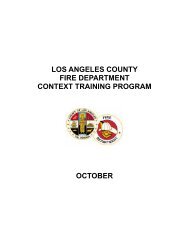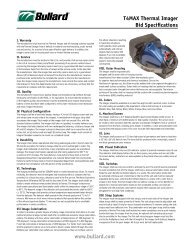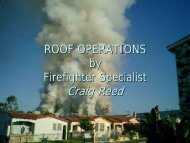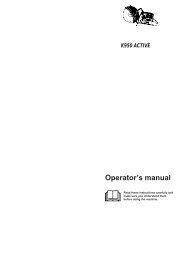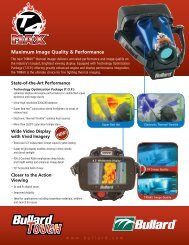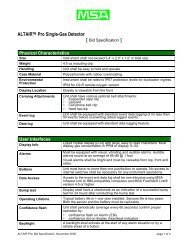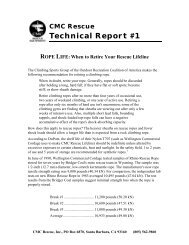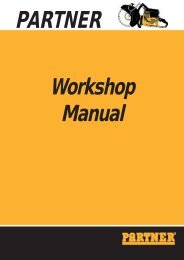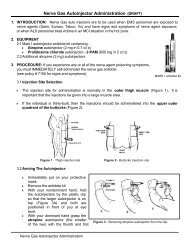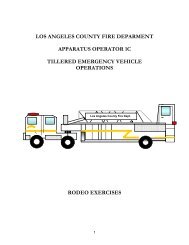You also want an ePaper? Increase the reach of your titles
YUMPU automatically turns print PDFs into web optimized ePapers that Google loves.
<strong>Apparatus</strong> <strong>Placement</strong><br />
Was this fire apparatus placed properly ?<br />
1
<strong>Apparatus</strong> <strong>Placement</strong><br />
There was 200 feet of skid mark<br />
This impact sent two patients from the<br />
civilian vehicle to a trauma center<br />
In front of the fire apparatus, fire crews<br />
were working a vehicle fire<br />
So was this fire apparatus placed<br />
correctly ?<br />
2
Yes Yes<br />
<strong>Apparatus</strong> <strong>Placement</strong><br />
What the Engineer did correctly<br />
– Protected the Engineer’s Engineer s panel<br />
– Protected the fire crews<br />
– Positioned the apparatus uphill /<br />
upwind<br />
– Was beginning to place cones / flares<br />
– They were on scene approximately 1<br />
minute prior to impact<br />
3
<strong>Apparatus</strong> <strong>Placement</strong><br />
<strong>Apparatus</strong> <strong>Placement</strong> at Incidents<br />
– Rescues<br />
– Freeway Incidents<br />
– Hazardous Materials Incidents<br />
– Structure Fires<br />
– Brush Fires<br />
– Near Railroads<br />
All in Volume D, Chapter 4, Subject 5<br />
4
Rescues<br />
<strong>Apparatus</strong> <strong>Placement</strong><br />
– Position for good access to incident<br />
– Leave access for Rescue Squads,<br />
Ambulances, and Law enforcement<br />
– Protect crews when necessary / Provide<br />
a safe environment<br />
– When using vehicle as a safety blocker,<br />
turn wheels to left or right<br />
This This will cause the vehicle to steer away<br />
from the incident upon an impact<br />
5
<strong>Apparatus</strong> <strong>Placement</strong><br />
Freeway Incidents<br />
– Protect fire crews and patients<br />
– Place apparatus between incident and oncoming<br />
traffic when possible – at least 150’ 150 to 200’ 200<br />
– When using vehicle as a safety blocker, turn wheels<br />
to left or right<br />
This will cause the vehicle to steer away from the<br />
incident upon an impact.<br />
– Keep traffic lanes open when possible<br />
– Position Engineer’s Engineer s panel away from traffic<br />
– Attempt to place apparatus uphill / upwind when<br />
possible<br />
Watch for leaking fuel or other fluids<br />
6
<strong>Apparatus</strong> <strong>Placement</strong><br />
Protect Your Crews !<br />
7
<strong>Apparatus</strong> <strong>Placement</strong><br />
Hazardous Materials / Terrorism<br />
Incidents<br />
– Approach incident from uphill / upwind<br />
direction<br />
– Position apparatus for immediate egress<br />
– Position apparatus uphill / upwind<br />
– Maintain zones (exclusion,<br />
contamination reduction, and support)<br />
– Be prepared for a mass<br />
decontamination operation<br />
8
<strong>Apparatus</strong> <strong>Placement</strong><br />
Structure Fires<br />
– Keep access points clear<br />
Be Be aware of other arriving apparatus and<br />
positions they may require<br />
– Ladder Trucks - Roof access points<br />
Facade laddering – 100% wall height + 10’ 10<br />
– Engine Companies - Fire attack points<br />
– Battalion Chief, Rescue Squads, and others<br />
– Hydrant locations / FDC<br />
– Fire location / Hose lines<br />
– Safety zone, Building height , collapse zone<br />
(1 ½ times height), Hazards, Exposures<br />
9
<strong>Apparatus</strong> <strong>Placement</strong><br />
Structure Fires<br />
– Remember<br />
We We can stretch hose, not ladders<br />
Engines Engines nosed together allows access to<br />
hose beds.<br />
Engines Engines parked elephant style blocks<br />
hose beds.<br />
– Approach from two opposite directions when<br />
possible.<br />
Allows easy access to hose beds<br />
Allows multiple hydrants and multiple<br />
water grids to be accessed.<br />
10
<strong>Apparatus</strong> <strong>Placement</strong><br />
Brush Fires<br />
– Keep roadway clear<br />
– Park next to bank, avoid chimneys,<br />
saddles, and unburned fuel<br />
– Back into position when possible<br />
(Structure Protection)<br />
– Turn wheels into bank / berm to<br />
prevent run-a-way run way vehicle<br />
– Keep windows up<br />
11
Brush Fires<br />
<strong>Apparatus</strong> <strong>Placement</strong><br />
– Incorporate a protector line<br />
– Utilize CO2 extinguisher for air filter fires<br />
– Dig a trench for water run off<br />
– Use hall runner to divert water<br />
– Attach a siamese or gated wye with adapters<br />
to auxiliary 2 ½” suction with a 2 ½” 50’ 50 hose<br />
laid out towards the front of the rig for a water<br />
tender to hook up to.<br />
12
<strong>Apparatus</strong> <strong>Placement</strong><br />
Near Railroads<br />
– Treat as active<br />
– Never across the tracks<br />
– Safe distance away<br />
– Same side as incident<br />
– Hose lines<br />
Utilize Utilize aerials to lay overhead - clearance<br />
Run Run underneath rail<br />
13
<strong>Apparatus</strong> <strong>Placement</strong><br />
General<br />
– Always curb wheels or turn wheels when blocking<br />
traffic<br />
– Always utilize chock blocks<br />
– Always leave emergency lights operating while at an<br />
emergency scene or parked in a non-legal non legal fashion<br />
– Always leave transmission in proper gear<br />
Engine running (while on scene) - Neutral or<br />
Pump gear<br />
General parking (Engine off / Parked legally)<br />
– Flat - Low gear or reverse<br />
– Uphill - Low gear<br />
– Downhill - Reverse<br />
14
General<br />
<strong>Apparatus</strong> <strong>Placement</strong><br />
– Always be aware of hazards<br />
Always be aware of hazards<br />
Electrical lines<br />
Other utility lines (Gas, Water)<br />
Building collapse probability and fall distance<br />
Other material falling distances<br />
Egress possibility<br />
Safety buffer zone<br />
Special Equipment<br />
– Mobil Air Units<br />
Upwind, ½ to 1 block from incident in clean air<br />
Light Units<br />
As directed by IC<br />
– Light Units<br />
15
Station<br />
<strong>Apparatus</strong> Security<br />
– Secure station grounds<br />
Gates / Doors<br />
– Keep compartment doors closed<br />
– Security lighting<br />
Incidents / Staging / Out in public<br />
– Stay with apparatus when possible<br />
– Secure vehicle if you must leave<br />
Windows / doors<br />
16



